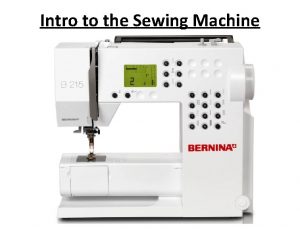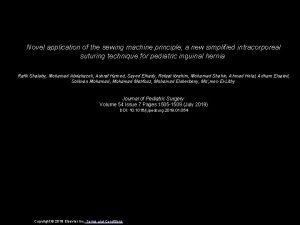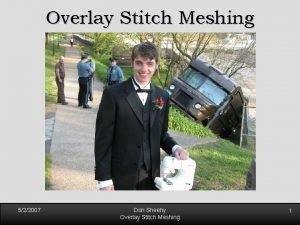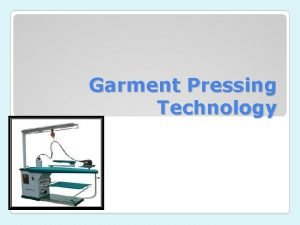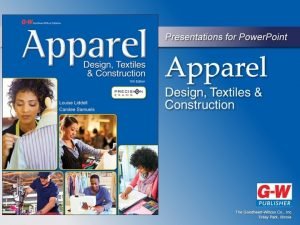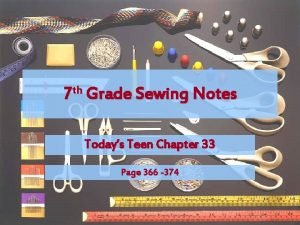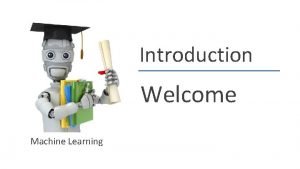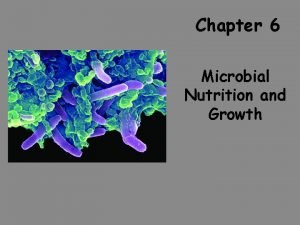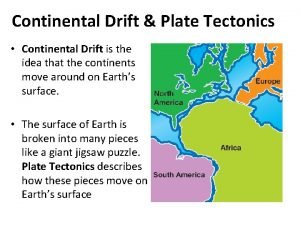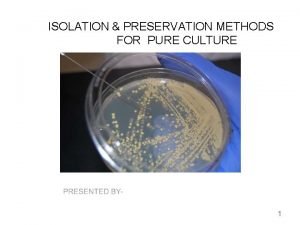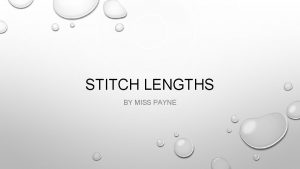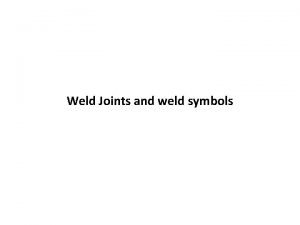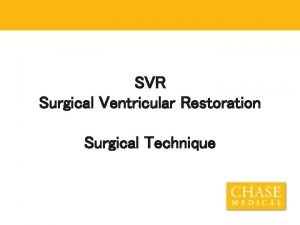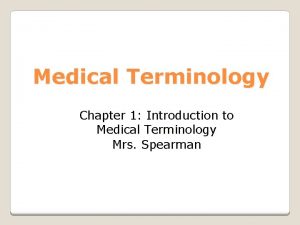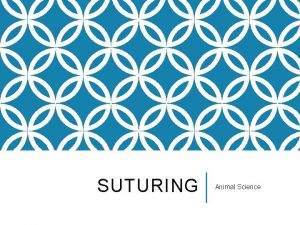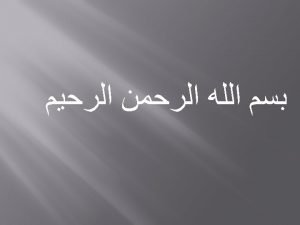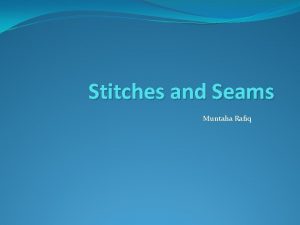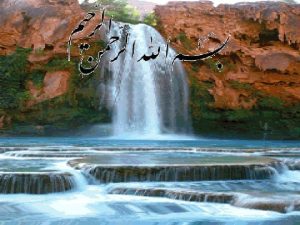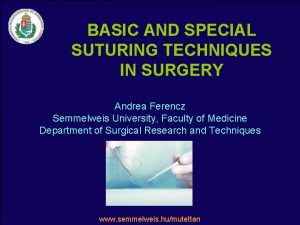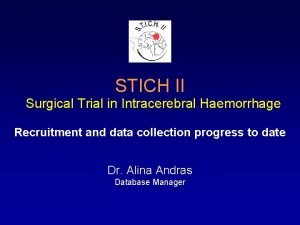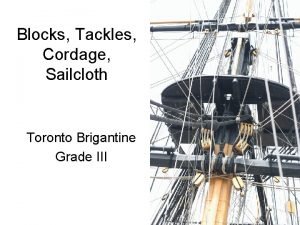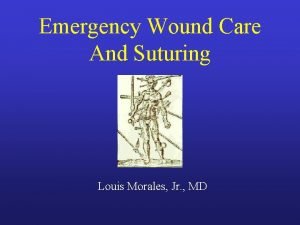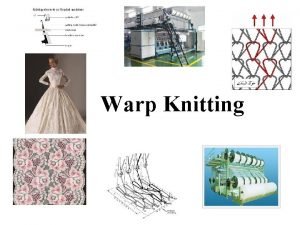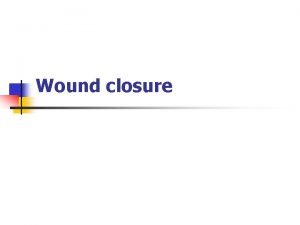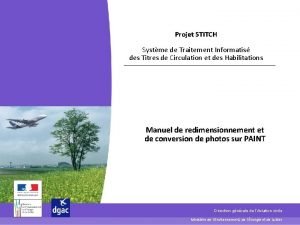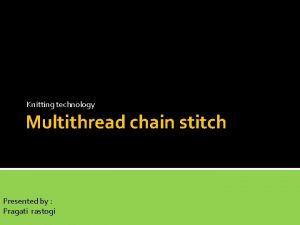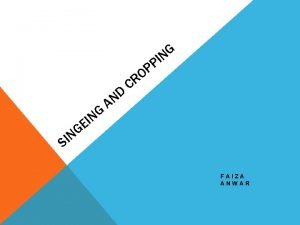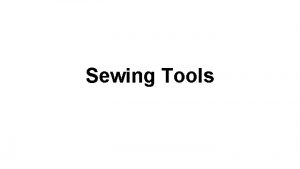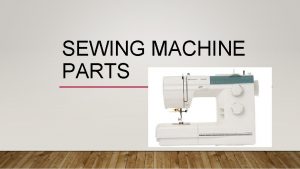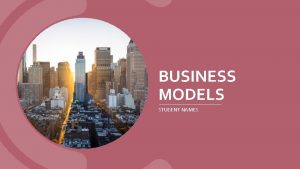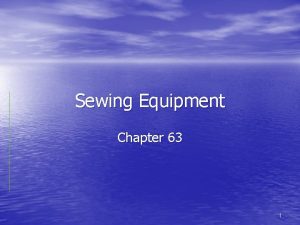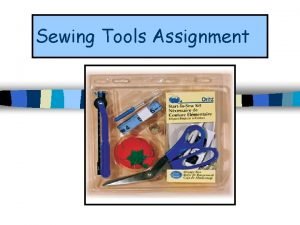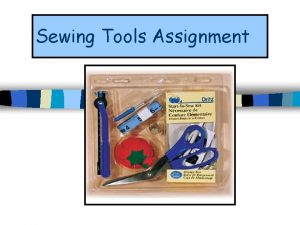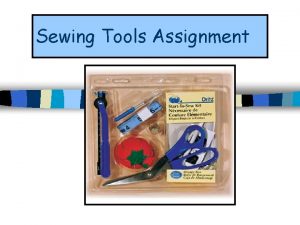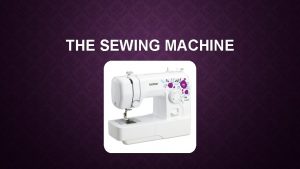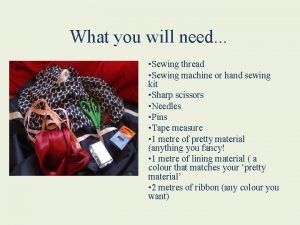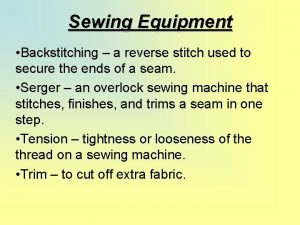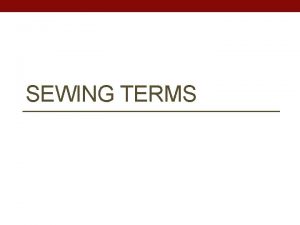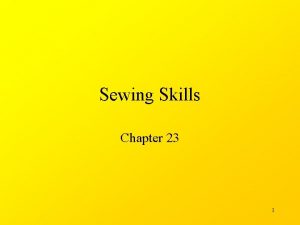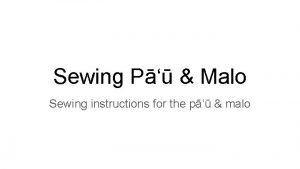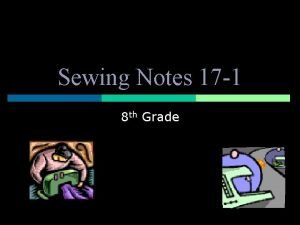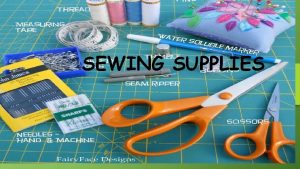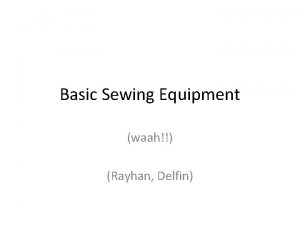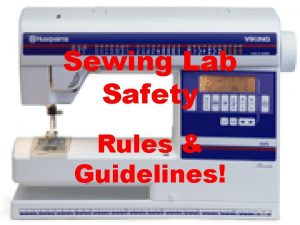Intro to the Sewing Machine 1 Stitch Plate


































- Slides: 34

Intro to the Sewing Machine

1. Stitch Plate Where the seam allowance guidelines are found. Each line is 1/8” apart, beginning with the inside edge of the presser foot, and ending with the far right edge of the stitch plate.

1/8 Inside Edge of the Presser Foot = _____” (No Line On the Stitch Plate)

1/4 Outside Edge of the Presser Foot = _____” (First Small Line)

3/8 First Long Line = _____”

1/2 Second Long Line = _____”

5/8 Third Long Line = _____”

3/4 Fourth Long Line = _____”

7/8 Fifth Medium Line = _____”

1 Right Edge of the Stitch Plate= _______”

2. Feed Dogs Toothed metal piece below the stitch plate that moves up and down to push the fabric along beneath the needle.

3. Presser Foot Holds the fabric down against the feed dogs to move the fabric evenly through the machine. There are several different types of presser feet, each designed to make a particular sewing task easier.

4. Machine Needle The upper thread is threaded through the machine needle. There are several different types of machine needles for different types of fabric and sewing techniques.

5. Thread Cutter Cutting tool on the left side of the sewing machine that allows for easy thread trimming.

6. Backstitch Button When pushed in, it allows you to sew backwards until it is released.

7. Presser Foot Lever Raises and lowers the presser foot. It is found on the back of the machine.

Bobbin Stop Bobbin Winder Thread Cutter 8. Bobbin Winder and Bobbin Stop Winds the thread around the bobbin. There is another thread cutter on the side of the bobbin stop.

Using the Serger 1. Some advantages of using a serger include: A. Cuts off excess fabric as it sews. B. Fastest way of finishing a seam. 2. The three rules of serging are: A. Keep your fingers away from the knife. B. Don’t lift up the presser foot. C. Leave a “thread tail” behind when finished. 3. Do not serge over pins, zippers or excessive bulk.

Sewing Equipment

1. Bobbin A small spool, made of plastic or metal, around which the lower thread of the sewing machine is wound. 2. Bobbin Case The part of the sewing machine that holds the bobbin.

3. Measuring Tape Flexible piece of equipment used to measure body measurements, grainlines and long distances.

4. Needle A small, slender piece of metal with a sharp point at one end ad a hole, or “eye” at the other. Used for hand sewing. 5. Needle Threader A small piece of equipment used to pull thread through the eye of a hand needle.

6. Pin Cushion Small cushion used to hold and sharpen straight pins. 7. Pins Holds layers of fabric together for cutting and sewing.

8. Rotary Cutting Equipment used to cut very straight, clean lines in fabric. Never use the rotary blade without the ruler or the cutting mat. Rotary Mat Rotary Ruler Rotary Cutter

9. Seam Gauge Metal six-inch ruler with a sliding marker. 10. Seam Ripper Useful tool that helps unpick small stitches.

11. Shears Sharp cutting tool to be used ONLY on fabric.

Sewing Terms

1. “Right” Side The patterned side of fabric that will be showing when you are done sewing your project. Sometimes called the “Pretty” side. “Right” Side “Wrong” Side

2. “Wrong” Side The back side of fabric that will be on the inside of the project you are sewing. Sometimes called the “Ugly” side. “Right” Side “Wrong” Side

3. Backstitch To machine stitch two or three stitches BACKWARDS on the same line at the beginning and end of a seam to secure the stitches.

4. Notches Diamond shaped symbols that extend beyond the cutting line on the pattern. They are used to match up pattern pieces. 5. Place-On-Fold Line An arrow with bent corners to indicate pattern must be placed and cut on a folded edge of fabric.

6. Seam The stitched line that is created by sewing. 7. Seam Allowance The distance between the edge of the fabric and the stitched line.

8. Selvage The tightly woven edges on fabric that runs lengthwise down the fabric. They should be touching when folded. Selvage

9. Slipstitch/Blind Stitch A hand stitch that is almost invisible on both the right and the wrong side of the project.
 Stitch plate definition
Stitch plate definition Label sewing machine parts
Label sewing machine parts It hinders moving when loosened and starts
It hinders moving when loosened and starts The sewing machine novel
The sewing machine novel Don sheehy sewing machine
Don sheehy sewing machine Pressing in garment industry
Pressing in garment industry Target sewing needles
Target sewing needles Marking tools in sewing
Marking tools in sewing Andrew ng intro machine learning
Andrew ng intro machine learning Andrew ng introduction to machine learning
Andrew ng introduction to machine learning Streak plate method
Streak plate method 7 lithospheric plates
7 lithospheric plates Pour plate method steps
Pour plate method steps Oreo tectonic plates
Oreo tectonic plates Streak plate vs pour plate
Streak plate vs pour plate Ease stitch length
Ease stitch length Welding joint symbol
Welding joint symbol Imbricating stitch
Imbricating stitch Zigzag stitch
Zigzag stitch Whats a husband stitch
Whats a husband stitch Rrhaphy medical term example
Rrhaphy medical term example Uninterrupted suture
Uninterrupted suture Mcevedy incision
Mcevedy incision Class 600 stitch
Class 600 stitch Baseball stitch classical cesarean
Baseball stitch classical cesarean Intracutane suturer
Intracutane suturer Stich 2
Stich 2 How a sail works
How a sail works Baseball stitch suture
Baseball stitch suture Shogging motion
Shogging motion Continuous stitch
Continuous stitch Stitch dgac
Stitch dgac Stitch type 402
Stitch type 402 Plate singeing machine
Plate singeing machine Diễn thế sinh thái là
Diễn thế sinh thái là
